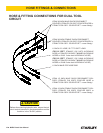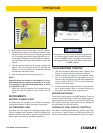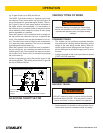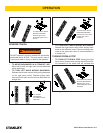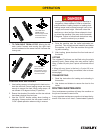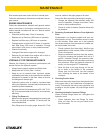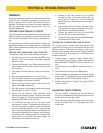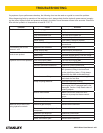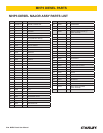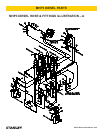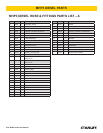
MHP3 Diesel User Manual ◄ 19
must be visible in the sight gauge at all times.
Secure the ller cap before restarting the engine.
– Change the hydraulic lter element every 200
hours of operation. Change more often if cold,
moist or dusty conditions exist.
– Check oil cooler for debris. Remove debris with
air pressure.
2. Removing Condensed Moisture From Hydraulic
Fluid
Condensation is a frequent problem with cool mo-
bile hydraulic circuits. This condition occurs in moist
or cold climates. When warm air in the hydraulic
tank draws moisture from the cooler air outside, wa-
ter accumulates in the tank.
– Check hydraulic uid level daily. Add uid per
specications in this manual (Refer to Hydraulic
Fluid in this section).
– Remove condensed moisture from the hydrau-
lic uid by pumping the hydraulic uid into a 5
gal/20 l container through the pressure hose.
Make sure the engine is at idle when performing
this procedure. When the hydraulic reservoir is
empty, turn the engine OFF immediately.
– Allow the uid to sit long enough for the wa-
ter to settle to the bottom of the container.
Slowly pour the uid back into the hydraulic
tank, avoiding the water at the bottom of the
container.
3. Checking Suction Hose
Make sure the suction hose (from the hydraulic tank
to the pump inlet) is not kinked and is clamped se-
curely. This reduces the risk of pump cavitation and
sucking air into the system. All pump ttings should
be tight.
4. Checking Hydraulic Lines and Fittings
Check for loose ttings, leaks, etc., throughout the
hydraulic circuit.
– Check hydraulic lines and ttings for leaks,
kinks, etc. daily. Do not use your hand to per-
form this check.
uid causes rapid wear and/or failure of internal parts.
Follow the maintenance instructions contained in the en-
gine manual.
ENGINE MAINTENANCE
Follow the maintenance schedule and general mainte-
nance instructions in the engine maintenance and op-
eration manual furnished with the unit. Normal mainte-
nance includes:
• Check the air lter daily. Clean if necessary.
• Replace dry air lter every 200 hours of operation.
• Replace fuel lter every 100 hours of operation.
• Change engine oil after rst 50 hours of operation,
then after every 200 hours of operation. Change
more often if cold, moist, or dusty conditions exist.
• Check oil level daily.
• Change oil lter when engine oil is changed.
• Remove dirt and debris from engine with a cloth or
brush daily. Do not use water spray.
HYDRAULIC SYSTEM MAINTENANCE
Observe the following for maximum performance and
service life from the hydraulic system.
• Always keep hydraulic system and uids clean.
• Keep water out of uid. (See 1. below.)
• Keep air out of hydraulic lines. Hydraulic system
overheating and foam at the hydraulic tank breather
indicate air is present in the lines. Keep all suction
line ttings and clamps tight.
• Hydraulic system wear is noted by increased heat
during tool operation, reduced tool performance and
eventual system breakdown.
• Operate with the uid temperature at 50–140 °F/10–
60 °C for improved seal and hose life, and maximum
efciency.
1. Filling The Reservoir
Make sure the engine is stopped before opening the
ller cap. Add uid as needed. Fill slowly with the
recommended uid.
Stop lling when the sight gauge shows full. Fluid
MAINTENANCE




